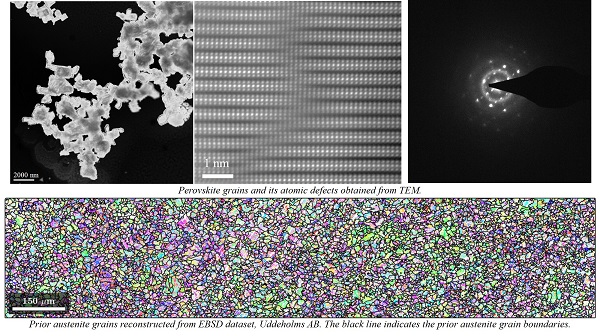Projects in technology and science
Learn about and be inspired by previously funded projects. Here are examples of collaborative projects that have been granted funding within the Verification for collaboration, VFS, initiative in 2020 and 2021.

Sustainable development will take its place in the governance of Region Gotland
In the spring of 2021, Region Gotland adopted the Regional Development Strategy 2040. Sustainable development is a central aspect of the strategy and affects many people on Gotland, not least the organisation itself, Region Gotland.
As sustainable development is not integrated in the current governance model, the intention is to develop, establish and deploy a sustainability budget for the Department of Technical Services through the Department and in collaboration with involved researchers. The initiative is a pilot project for all of Region Gotland, which after the 2022 elections plans to rework and develop the current governance model to include sustainable development.
The results of the project will contribute to increased knowledge of sustainability governance – something that will become increasingly central to both public organisations and private companies.
Contact
Sustainable development will take its place in the governance of Region Gotland
Department of Civil and Industrial Engineering together with Åbo Akademi University and Region Gotland.
Responible academic researcher: Mathias Cöster

Nicotine pouches: Optimisation and new possibilities
One of the most important Sustainable Development Goals (SDG) set by the United Nations, is number 3 – well-being. This study aims to be part of tackling one of the biggest societal health challenges, ie the use of tobacco-based products.
It is estimated that over 80% of the world’s 1.3 billion tobacco users live in low- and middle-income countries. In order to curtail the harmful effects of using tobacco products, a number of tobacco-free, nicotine-based products are available on the market.
However, there is a need for improving the functionality of these products in terms of optimisation of nicotine release, in order to relieve withdrawal symptoms and minimise the adverse effects. Moreover, the pouches that are placed under the lip, typically for nicotine, could be further explored for other niche applications within life science.
This study will explore the complex interactions between nicotine, microcrystalline cellulose (one of the key excipients for formulating nicotine and other pharmaceuticals) and moisture. This study will also look into the recent trends in microcrystalline cellulose products and the related intellectual property (IP) landscape.
Contact
Nicotine pouches: Optimisation and new possibilities
Department of Materials Science and Engineering in collaboration with the Swedish company the Habit Factor.
Responsible academic researcher: Albert Mihranyan

Advanced analysis of nanocrystals at the atomic scale for industry and applied solar research
New, improved materials often lay the foundation for major technological advances. A common factor shared by both perovskite (a structural class with many applications) and metal carbides (prevalent in powder steel technology) is that the quality of crystallisation is key to the function of the materials.
This is important, for example, in the production of metal tools and solar cells. The project will investigate the mechanism of crystallisation and its impact on size, function and quality, using the Ångström Laboratory’s advanced analytical equipment, such as TEM, XRD and ion beam analysis.
Through increased theoretical knowledge of crystal formation at the nanoscale, 3D printing of powder steel and thin film deposition of perovskites can be controlled to achieve the desired crystal structure and properties.
The increased knowledge will lead to reduced energy and material consumption during production and a reduced climate footprint.
Contact
Advanced analysis of nanocrystals at the atomic scale for industry and applied solar research
Department of Chemistry - Ånström Laboratory in collaboration with Uddeholms AB.
Responsible adademic researcher: Malin Johansson

Growing bacterial cultures studied in new way in fight to save lives
Rapid and optimal antibiotic treatment for patients in need saves lives and combats antibiotic resistance. Getting the right diagnosis and treatment is a battle against time. Automated analysis of microscope images from live bacterial cultures is a powerful tool for visualising bacterial growth.
This project will investigate the benefits of using multispectral images in this type of antibiotic sensitivity testing. The project is expected to show that the use of multispectral microscopy images to quantify bacterial growth patterns may make it possible to determine whether a patient’s bacteria are resistant to a particular treatment more quickly, and distinguish between bacteria of different species earlier and more accurately. Such an outcome is likely to contribute to even better solutions for infection diagnostics as well as to methodological developments in research on e.g. cancer drugs.
Contact
Growing bacterial cultures studied in new way in fight to save lives
Department of Civil and Industrial Engineering in collaboration with Q-linea AB.
Responsible academic researcher: Mats Gustafsson

Luminescent thin film materials for effective killing of bacteria and viruses
Further development of methods to create materials with large variations in composition, and thereby optimise material properties, is important for many different research fields and industries. Advances in thin film technology can also play an important role in preventing future pandemics.
This project will study new methods for creating materials for the next generation of UV light source. Ultraviolet light is a strong killer of bacteria and viruses in a limited wavelength range. The project aims to serve as a first verification of the feasibility of using thin film technology to create luminescent materials that can be optimised for bacteria and virus killing.
The goal is to create light sources with greater energy efficiency, longer durability and adaptable properties, such as adapted wavelength ranges for killing different types of microbes.
Contact
Luminescent thin film materials for effective killing of bacteria and viruses
Department of Electrical Engineering in collaboration with LightLab Sweden AB.
Responsible academic researcher: Tomas Kubart

Formal verification of modular software using domain theories
The development of software for safety-critical systems, such as railway signalling systems, is costly as it requires extensive quality assurance measures.
Use of formal methods is a technique that reduces costs and increases the reliability of quality assurance. It is a technique that is already in use today and, if further developed, can contribute to increased safety and reduced costs in infrastructure projects.
The project aims to develop new methods for formal verification of modular software and checking configuration data using domain theories and mathematical models of the reality in which the software works.
Contact
Formal verification of modular software using domain theories
Department of Information Technology in collaboration with Prover Technology AB.
Responsible academic researcher: Lars-Henrik Eriksson

Protective layers should make smart windows even smarter
Smart windows use electrochromism (EC), an energy-saving technology which allows control of the solar heat and light transmission. A building with smart glass windows can therefore significantly reduce its energy consumption, and thus the cost, for cooling, air conditioning and illumination. An additional plus is that indoor comfort can increase.
Smart windows have been commercially available for some years but have not yet made a breakthrough. EC devices consist of dynamic materials in several thin layers and still suffer from compatibility oriented issues between these layers, such as degradation, dark spots and cracks.
This ultimately reduces performance and product quality. In this project, Ilknur Bayrak Pehlivan, a researcher at the Department of Materials Science and Engineering in collaboration with Sisecam, which is the largest flat glass manufacturer in Europe, will develop and adapt oxide thin film protective layers to EC systems. More specifically, preparation and characterization of oxide thin film protective layers between electrochromic and polymer electrolyte layers is targeted.
The project aims to contribute new knowledge in the field of protective layers and improve the EC properties and durability of EC systems. The project will also be a basis for continued research on multi-functional EC devices, which in addition to controlling heat and light can provide energy storage and energy production. By joining forces and combining fundamental research and industrial experience to advance the development of EC technology this project can help realise the enormous potential for energy savings in modern buildings.
Contact
Protective layers should make smart windows even smarter
Department of Materials Science and Engingeering
Contact: Ilknur Bayrak Pehlivan

Implementation Test Bed 2020
Organisations that provide assistive devices in Sweden need to get better at introducing new products and services to meet the needs of users now and in the future. There are both strong demographic and economic drivers for realising the potential for innovation.
Implementation Test Bed 2020 is a project led by Klas Palm, a researcher at the Department of Civil and Industrial Engineering, in partnership with the Dalarna Assistive Devices Centre (Dalarnas Hjälpmedelscenter) that is tackling the challenge of implementing innovative solutions at providers of assistive devices from both the practical and the theoretical perspectives. Within the framework of the project, organisational capacity to implement technical innovations will be strengthened and implementation processes developed. In parallel, implementation of innovative solutions will be initiated in the areas of preventive work with technology that helps enhance people’s sense of security, remote interventions and fall prevention technology.
Increasing the understanding of implementation problems in complex organisations is a valuable aspect of the effort to deliver better, more cost-effective healthcare in Sweden and elsewhere in the world. The prerequisites exist within the project to spread the knowledge created to other regions and operational areas and contribute to academic innovation research.

Improving patient safety in the medication chain
Patients in hospitals are given medications as prescribed in the patient charting system, which involves a chain of critical steps that in Swedish hospitals are currently based entirely on manual control without support systems.
With the advent of this collaborative project, the first implementation of digital support for pharmaceutical validation in Sweden is being planned within Region Uppsala, where prescriptions will be integrated with relevant data from the electronic patient chart. This creates a “closed medication loop” in which no manual transfer of information is necessary or even possible, which eliminates the risk of human error and makes pharmaceutical treatment safer and thus improves patient safety.
Thomas Lind and Åsa Cajander at the Department of Information Technology at Uppsala University are contributing with critical expert knowledge for implementation of the project with their many years of experience in action research and profound knowledge on the implementation of IT systems in healthcare. The project gives researchers the opportunity to deepen their understanding of implementation with regard to the implementation of IT in healthcare in particular.
This pre-study represents an important step forward in Region Uppsala’s digital transformation and because the charting system used in the region is widely used in the rest of the country, good solutions have huge potential to be scaled up and spread to additional healthcare providers.
Contact
Improving patient safety in the medication chain
Department of Information technology
Contact:Thomas Lind and Åsa Cajander

Greater understanding of abrasive soil
Efficiency improvement is a never-ending quest in agriculture. The point of departure for the partnership between Urban Wiklund’s research group at the Department of Materials Science and Engineering and Väderstad Components, a private company, is that greater understanding of machine parts that work in and are worn out in the soil can advance such a development. Greater wear-resistance extends the lifetime of components, saves time, lowers the cost of replacing operating parts exposed to wear and keeps agricultural equipment running efficiently for longer.
By closely studying abrasion mechanisms on operating parts exposed to wear from fields, evaluating current testing methods and carrying out supplementary field tests, the partners hope to be able to validate the company’s laboratory method for abrasion rate as the first practical result. Detailed studies in a scanning electron microscope (SEM) to gain greater understanding of abrasion processes is a specialised field at Uppsala University, but unlike abrasive rock and gravel, the tribology research group has not so far studied soil.
The project thus gives the researchers an opportunity to deepen their knowledge in a new field in order to contribute new tribological understanding that will benefit continued research and new applications for modern agriculture. The project is also expected to contribute to a significant knowledge boost related to how different types of soil affect the abrasion of components in a broad sense.
Contact
Greater understanding of abrasive soil
Department of Materials Science and Engineering
Contact: Urban Wiklund
.jpg)
New technology for better harvesting of solar energy being experimentally evaluated
A new technology that can significantly increase electricity and heat production from solar radiation is under development in the lab of Ilia Katardjiev, Professor of Solid State Electronics at the Department of Electrical Engineering.
It involves a new design principle to effectively concentrate both diffuse sunlight and direct solar radiation, thereby enabling a significantly higher solar cell utilisation rate than with the technologies available today.
Through a collaboration with the company PlasticProdukter, the new technology will be experimentally demonstrated and evaluated. The company’s expertise in optical materials and manufacturing methods is key to implementation.
The activities of the project revolve around choice of material and a suitable manufacturing method as well as the design, manufacture and characterisation of optical components. Performance, production volume and manufacturing cost are all important parameters in the further development of the technology.
Contact
New technology for better harvesting of solar energy being experimentally evaluated
Department of Electrial Engineering
Contact: Ilia Katardjiev
